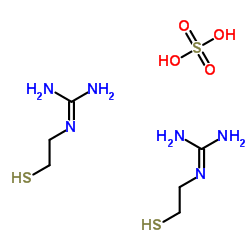MEG hemisulfate

MEG hemisulfate structure
|
Common Name | MEG hemisulfate | ||
|---|---|---|---|---|
| CAS Number | 3979-00-8 | Molecular Weight | 336.456 | |
| Density | N/A | Boiling Point | 645.7ºC at 760 mmHg | |
| Molecular Formula | C6H20N6O4S3 | Melting Point | N/A | |
| MSDS | Chinese USA | Flash Point | 344.3ºC | |
Use of MEG hemisulfateMEG (Mercaptoethylguanidine) hemisulfate is a potent and selective inhibitor of the inducible NO synthase (iNOS), with EC50s of 11.5, 110, and 60 μM for iNOS, ecNOS, and bNOS respectively in tissue homogenates. MEG hemisulfate is also a potent scavenger of peroxynitrite and inhibits peroxynitrite-induced oxidative processes. MEG hemisulfate has a protective effect in many experimental models of inflammation, including ischemia/reperfusion injury, periodontitis, hemorrhagic shock, inflammatory bowel disease, and endotoxic and septic shock[1][2][3][4]. |
| Name | Mercaptoethylguanidine hemisulfate salt |
|---|---|
| Synonym | More Synonyms |
| Description | MEG (Mercaptoethylguanidine) hemisulfate is a potent and selective inhibitor of the inducible NO synthase (iNOS), with EC50s of 11.5, 110, and 60 μM for iNOS, ecNOS, and bNOS respectively in tissue homogenates. MEG hemisulfate is also a potent scavenger of peroxynitrite and inhibits peroxynitrite-induced oxidative processes. MEG hemisulfate has a protective effect in many experimental models of inflammation, including ischemia/reperfusion injury, periodontitis, hemorrhagic shock, inflammatory bowel disease, and endotoxic and septic shock[1][2][3][4]. |
|---|---|
| Related Catalog | |
| Target |
IC50: 11.5 μM (iNOS), 110 μM (ecNOS), 60 μM (bNOS)[1] |
| In Vitro | MEG (0.1-1000 μM; 18 h) reduces nitrite accumulation in the supernatant of cultured J774.2 macrophages activated with LPS (10 μg/mL) and INF (50 μg/mL). MEG inhibits iNOS activity in homogenates of lungs taken from LPS-treated rats[1]. MEG (1 μM-3 mM; 3 min) dose-dependently inhibits the peroxynitrite-induced oxidation of cytochrome c2+ and hydroxylation of benzoate[2]. MEG (1-300 μM) inhibits the suppression of mitochondrial respiration and DNA single strand breakage in response to peroxynitrite in J774 cells[2]. MEG (300 μM; 30 min) inhibits the suppression of vascular contractility in response to peroxynitrite in thoracic aortic rings[2]. |
| In Vivo | MEG (10 mg/kg; i.p. for 5 d) attenuates the degree of lipid peroxidation, protein oxidation, and peroxynitrites level and ameliorated the decrease of antioxidant enzymes activities in the esophagus of rats subjected to caustic burn injury[3]. MEG (30-60 mg/kg; a single i.p.) decreases mean arterial blood pressure (MAP) of normal rats[1]. MEG (10 mg/kg; a single i.p.) improves the renal dysfunction and tissue injury induced by ischemia/reperfusion (I/R) of rat kidney[4]. Animal Model: Sprague-Dawley rats (200-250 g) were injured the esophagus[3] Dosage: 10 mg/kg Administration: I.p. for 5 days Result: Reduced the stenosis index (SI) and the histopathologic damage score. Decreased the malondialdehyde and protein carbonyl content and increased the activities of superoxide dismutase and glutathione peroxidase. Regulated the nitrate and nitrite level. |
| References |
| Boiling Point | 645.7ºC at 760 mmHg |
|---|---|
| Molecular Formula | C6H20N6O4S3 |
| Molecular Weight | 336.456 |
| Flash Point | 344.3ºC |
| Exact Mass | 336.070801 |
| PSA | 284.38000 |
| LogP | 1.60840 |
| Personal Protective Equipment | Eyeshields;Gloves;type N95 (US);type P1 (EN143) respirator filter |
|---|---|
| Hazard Codes | Xi |
| RIDADR | NONH for all modes of transport |
|
Nitric oxide is synthesized in acute leukemia cells after exposure to phenolic antioxidants and initially protects against mitochondrial membrane depolarization.
Cancer Lett. 215(1) , 43-52, (2004) We investigated the early events involved in loss of mitochondrial membrane potential (DeltaPsi(mt)) leading to apoptosis in cells derived from patients with acute lymphocytic leukemia after exposure ... |
|
|
Mitogen-activated protein kinase phosphorylation in kidneys of beta(s) sickle cell mice.
J. Am. Soc. Nephrol. 11(6) , 1026-32, (2000) Previous studies in beta(s) sickle cell mice demonstrated renal immunostaining for nitrotyrosine, which is putative evidence of peroxynitrite (ONOO(-)) formation. ONOO(-) is known to nitrate tyrosine ... |
|
|
Inhibition of nitric oxide synthase ameliorates cellular injury in sickle cell mouse kidneys.
Kidney Int. 58(1) , 82-9, (2000) In previous studies of transgenic sickle cell mice, increased renal expression of inducible nitric oxide synthase (iNOS) and endothelial cell isoform of NOS (EcNOS) was found by Western blot and immun... |
| 2-(2-Sulfanylethyl)guanidine sulfate (2:1) |
| 2-(2-sulfanylethyl)guanidine,sulfuric acid |
| Guanidine, N''-(2-mercaptoethyl)-, sulfate (2:1) |
| MEG hemisulfate salt |